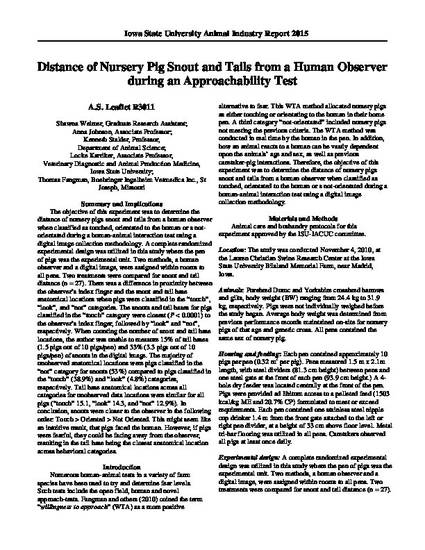
The objective of this experiment was to determine the distance of nursery pigs snout and tails from a human observer when classified as touched, orientated to the human or s not-orientated during a human-animal interaction test using a digital image collection methodology. A complete randomized experimental design was utilized in this study where the pen of pigs was the experimental unit. Two methods, a human observer and a digital image, were assigned within rooms to all pens. Two treatments were compared for snout and tail distance (n = 27). There was a difference in proximity between the observer’s index finger and the snout and tail base anatomical locations when pigs were classified in the “touch”, “look”, and “not” categories. The snouts and tail bases for pigs classified in the “touch” category were closest (P < 0.0001) to the observer’s index finger, followed by “look” and “not”, respectively. When counting the number of snout and tail base locations, the author was unable to measure 15% of tail bases (1.5 pigs out of 10 pigs/pen) and 33% (3.3 pigs out of 10 pigs/pen) of snouts in the digital image. The majority of unobserved anatomical locations were pigs classified in the “not” category for snouts (53%) compared to pigs classified in the “touch” (38.9%) and “look” (4.8%) categories, respectively. Tail base anatomical locations across all categories for unobserved data locations were similar for all pigs (“touch” 15.1, “look” 14.3, and “not” 12.9%). In conclusion, snouts were closer to the observer in the following order: Touch > Oriented > Not Oriented. This might seem like an intuitive result, that pigs faced the human. However, if pigs were fearful, they could be facing away from the observer, resulting in the tail base being the closest anatomical location across behavioral categories.
Available at: http://works.bepress.com/kenneth_stalder/110/
